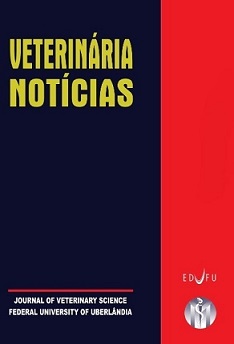Comparison of the effect of hatchery disinfection with peracetic acid andglutaraldehydeassociated with quaternary ammonia compounds on the tracheal mucosa of one day old chicks
Keywords:
desinfetantes, traqueia, cílios, nascedouros, Gallus gallusAbstract
This study aimed at identifying lesions in the respiratory tract of chickens
caused by hatchery disinfection, performed by micro-sprinkler with
peracetic acid and ammonia associated with glutaraldehyde. The
experiment was conducted at a hatchery in Uberlândia - MG, in June
2013. Three hatcheries were employed, each one using a different
treatment process. All process had been conducted in the same room and
had the same mechanisms of temperature, humidity and ventilation
control. Process 1 (P1) was sprayed with a solution of peracetic acid (two
ml per liter of water, total of 300 ppm); P2 was sprayed with a solution of
glutaraldehyde associated with ammonia (one ml of water per liter, total of
450 and 75 ppm); and P3 was sprayed only with distilled water. At the end
of 48 hours, 16 chicks per treatment process were collected at each
outbreak to remove the trachea. Each trachea was divided into two
samples. One sample was processed for evaluation by optical microscope
and another was processed for evaluation by transmission electron
microscope. The observation of the slides had 10 fields for evaluation, so
that all tracheal mucosa on each slide was observed for the definition of
scores according to the degree of the found lesions. At the result, there was
a significant difference only in the material evaluated by light microscopy
between chicks exposed to environmental ammonia and glutaraldehyde
(P2) related to the control group (P3), considering that these chicks showed
more severe injuries, such as areas with less cilia and areas of tracheal
mucosa flaking. Chicks exposed to disinfection with peracetic acid in
hatcheries did not show lesions of the tracheal mucosa. Therefore, when
using the dosages in this study, peracetic acid can be used for the
disinfection of hatcheries to reduce the contamination present during the
process, while causing less damage to the tracheal mucosa of chicks.

